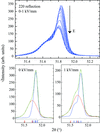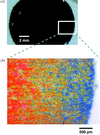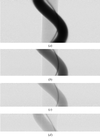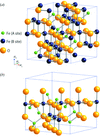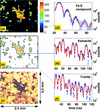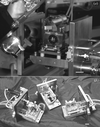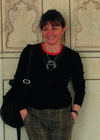issue contents
September 2012 issue

Cover illustration: Two-dimensional grazing-incidence X-ray diffraction pattern from a 15 nm-thick rubrene crystalline thin film grown on the surface of a tetracene single crystal, collected while rotating the sample by a full turn about the normal to the sample surface (see Fumagalli, Campione, Raimondo, Sassella, Moret, Barba and Arrighetti, pages 682-687). The colour bar shown in the figure represents the diffracted intensity scale in arbitrary units. On the image are superimposed the calculated positions of the diffraction spots from polycrystalline TEN with the (001) planes parallel to the sample surface (green circles), and from polycrystalline RUB with the (200) planes parallel to the sample surface (black circles), along with the Miller indices of the most relevant spots.
facility information
research papers
 access
access access
access access
access access
accessshort communications
beamlines
computer programs
current events



 journal menu
journal menu




























